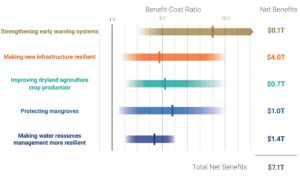This Guest Article for REVITALIZATION was written by Emily Wasley of WSP.
In 2020, the year we faced a global pandemic, record-breaking wildfires and political unrest across the U.S., demand for our corporate climate risk, adaptation and resilience services increased by 305 percent.
This remarkable growth illustrates the increasing interest from publicly traded and privately held companies to enhance their environmental, social and governance (ESG) efforts – going beyond sustainability to begin identifying and managing their climate-related risks and opportunities through resilience.
Given the significant experience in resilience and the growth we are observing in real-time, there are three key trends we see emerging in climate resilience for corporations in response to the COVID-19 pandemic.
1. Mandatory Climate-related Financial Risk and Opportunity Disclosures
The request from investors for publicly traded companies to align with the Task Force on Climate-related Financial Disclosures (TCFD) has increased considerably over the past year. In 2020, major investors like BlackRock, State Street and Vanguard strongly encouraged their investees to publicly disclose the financial impacts associated with — and management measures in place to address — current and future climate-related risks and opportunities.
In 2021, we saw an uptick in domestic and international government interest in understanding, assessing, disclosing, and addressing substantive climate-related financial risks and opportunities. In March, the U.S. Securities and Exchange Commission created a Climate and ESG Task Force in the Division of Enforcement and issued a request for public comment on climate change disclosure.
Also, in March the Commodity Futures Trading Commission established a new Climate-Risk Unit to focus on “the role of derivatives in understanding, pricing and addressing climate-related risk and transitioning to a low-carbon economy,” while the Federal Reserve launched a second committee focused on climate change known as the Financial Stability Climate Committee. This new committee will focus on the risks that global warming poses to the entire financial system.
In May, President Joe Biden signed an executive order on Climate-related Financial Risk, followed by the G7 announcing support for mandatory climate reporting in June. These efforts signal a path towards regulatory measures to mandate climate-related financial risk and opportunity disclosures in the very near future.
Organizations that have been publicly disclosing this information through frameworks such as CDP, Dow Jones Sustainability Indices, GRESB or TCFD are well positioned to respond to future regulatory requirements. For those who have yet to explore what climate-related risks and opportunities mean for their business, operations and supply chain, they will likely look to their peers and organizations like WSP, who have decades of experience in this space, for technical and strategic support.
This could be an incredible opportunity for the private and public sectors to share data and key findings, gather at the same table to discuss their shared challenges, and identify collaborative measures and finance mechanisms to address these climate risks and opportunities.
2. Organizational Changes to Embed Climate Risk and Resilience
For years, organizations have employed chief risk officers to serve as corporate executives responsible for assessing and mitigating significant competitive, regulatory and technological threats to an enterprise’s capital and earnings.
As the frequency, intensity and evolution of different ESG and security threats change over time, we are seeing an increased need for chief risk officers to leverage strategic foresight to prepare for and respond to a variety of man-made, natural and climate-induced threats, both acute and chronic in nature.
To ensure that organizations are Future Ready™, they will need to transition from a more traditional reactive approach to be more proactive to adequately address current and future risks. The global pandemic shed significant light on those organizations that were more prepared than others because of the resilience and diversity of their enterprise, systems, workforce, operations and services.
Organizations that want to remain competitive, profitable and relevant will need to consider some organizational change management measures to ensure that they have the right executives in place with backgrounds in resilience and proactive preparedness to all hazards – climate being one of many our world faces. This may mean the transition of chief risk officers into chief resilience officers (CROs)—a role created by The Rockefeller Foundation’s (failed) 100 Resilient Cities initiative—where more than 80 CROs have been hired and trained to lead their cities’ resilience work. The CRO reports directly to the city’s chief executive and acts as the city’s point person for resilience building.
With the increasing need for organizations to prepare for complex, global threats, it is imperative they prioritize organizational changes like hiring a CRO to proactively anticipate and manage such threats.
Training and educational resources are also needed if more organizations seek CROs who are qualified and have the experience needed to lead an organization’s enterprise resilience across both the acute shocks and threats it may face; but also the more chronic, gradual changes that are systemic in nature and require more proactive strategic foresight. CROs also have experience exercising for the known unknowns – threats that pose a potentially greater risk simply because their magnitude and likelihood cannot be anticipated based on previous experience.
3. Innovative Climate Adaptation and Resilience Finance Mechanisms
COVID-19 may have dominated the news in 2020, but for many people around the world, the ever-present climate crisis exacerbated that into an even bigger danger to their lives and livelihoods.
With the Australian bushfires, costing $5 billion; super-cyclonic storm Amphan devastating India, Sri Lanka, and Bangladesh, costing $13 billion; the Atlantic Hurricane season powering through the U.S. and Central America, costing $40 billion; floods overwhelming China, costing $32 billion; and unprecedented wildfires ravaging the U.S. West Coast, costing $20 billion; almost every part of the globe was impacted by climate-related disasters in 2020, with catastrophic results for millions of people.
Between 2017-2018, adaptation finance gained momentum, increasing 35 percent to an annual average of $30 billion from $22 billion in 2015-2016. This increase is indicative of the increasing importance of climate-resilient development and the urgency to build adaptive capacity to manage climate change vulnerabilities.
However, according to the Global Commission on Adaptation (GCA), adaptation finances continue to fall drastically short of the required global financing of $180 billion annually for 2020-2030. The GCA has estimated that investing $1.8 trillion into adaptation and resilience measures globally in five areas from 2020 to 2030 could generate $7.1 trillion in total net benefits.
The five areas they consider are:
- early warning systems;
- climate-resilient infrastructure;
- improved dryland agriculture;
- mangrove protection; and
- investments in making water resources more resilient.

©GLOBAL COMMISSION ON ADAPTATION The Global Commission on Adaptation in its report, Adapt Now: A Global Call for Leadership on Climate Resilience, estimates investing $1.8 trillion into adaptation and resilience in five areas from 2020 to 2030 could generate $7.1 trillion in total net benefits.
It is critical that major corporations with global supply chains, impacts and footprints contribute to financing adaptation and resilience projects.
Some organizations are beginning to invest in adaptation and resilience; however, the corporate sustainability projects intended to reduce greenhouse gas emissions or spur technological advances in renewable energy and the financing mechanisms available to fund these efforts are much further along.
While adaptation and resilience must be embedded into these sustainable projects, new innovative climate adaptation and resilience finance mechanisms from the corporate sector are needed now.
Cities and other organizations like the international Climate Bonds Initiative have been exploring frameworks to guide green bond standards and resilience investments more broadly.
However, more creative, innovative, and collaborative climate adaptation and resilience finance mechanisms are needed to manage and address the current and future risks and opportunities communities face in a changing climate.
Conclusion
As many of us can attest, 2020 was a pivotal year on many fronts. It required all of us, globally, to pause and rethink our priorities.
One priority that rose to the top for many organizations, cities and countries was the concept of resilience and adaptive capacity to weather any threat or stressor they, and we collectively, may face. COVID-19 was one such threat faced by the entire world and from which we will gather many lessons learned.
If these three trends come to fruition over the next year and beyond, we will be on a better path to collectively and collaboratively address climate change.
About the Author:
 Emily Wasley is Practice Leader and Future Ready Advisor Sustainability, Energy and Climate Change at WSP.
Emily Wasley is Practice Leader and Future Ready Advisor Sustainability, Energy and Climate Change at WSP.
She has over 16 years of experience in the climate change, sustainability, adaptation, and resilience fields helping government entities, water utilities, and Fortune 50 to 500 corporations institutionalize climate considerations into existing risk management, business continuity, and sustainability efforts.
She leads WSP’s corporate climate risk, adaptation, and resilience work supporting clients in identifying, assessing, and managing climate-related risks and opportunities the various risks and opportunities in alignment with the Task Force on Climate-related Financial Disclosures (TCFD) recommendations.

